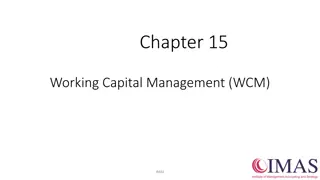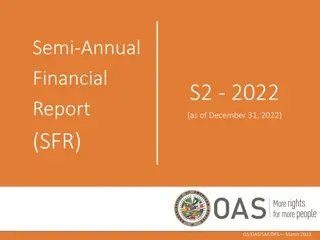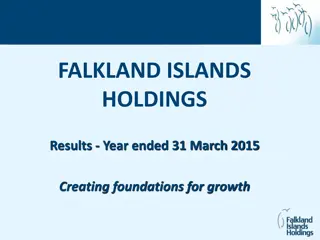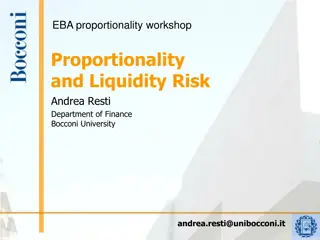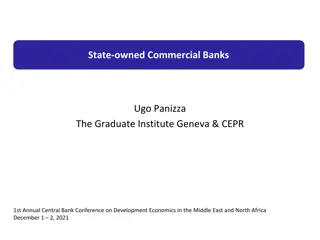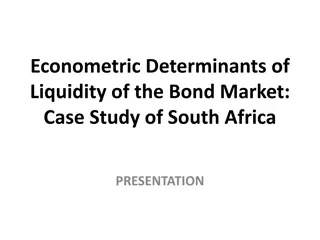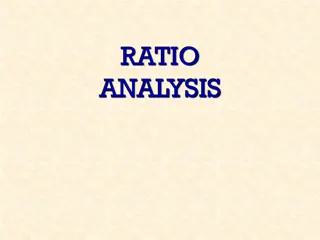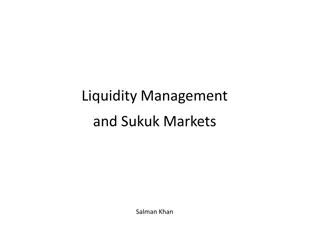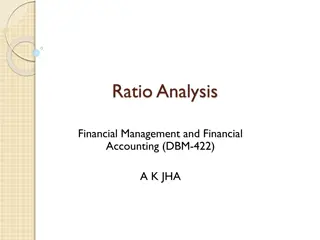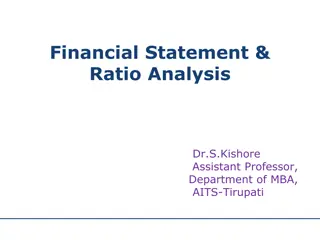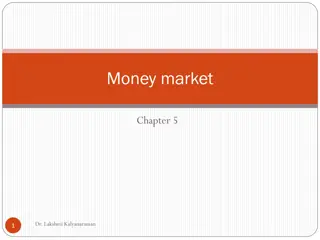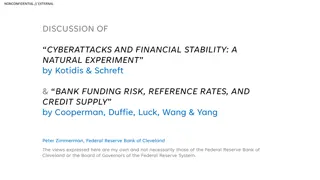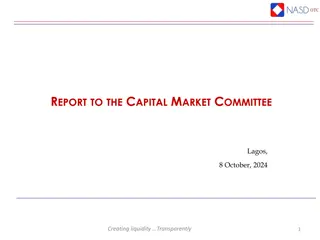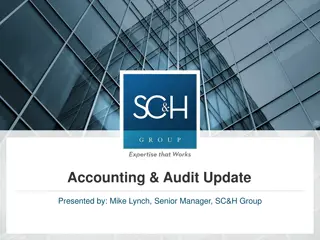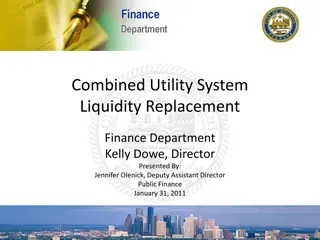Revolutionizing Financial Systems with Aquo Protocol
Aquo aims to integrate global financial systems into a unified protocol, addressing issues like limited liquidity, high costs, and restricted access to diverse assets. By tokenizing Real World Assets and offering innovative solutions, Aquo empowers investors with enhanced liquidity, global access, a
2 views • 10 slides
Financial Analysis of Petrisin Company for Fiscal Year Ended December 31, 2014
The financial analysis of Petrisin Company for the fiscal year ending December 31, 2014, reveals key financial information including sales, costs, gross margin, operating expenses, income from operations, net income, and more. The analysis highlights the company's performance in terms of profitabili
2 views • 12 slides
Understanding Quantitative Credit Control Methods in RBI's Monetary Policy
RBI's monetary policy revolves around maintaining credit quantity in the market through quantitative credit control methods. This includes Bank Rate Policy, Open Market Operations, Cash Reserve Ratio (CRR), and Statutory Liquidity Ratio (SLR). These tools help regulate credit flow, liquidity, and ma
4 views • 8 slides
Analysis of Contemporary Macroeconomic Issues in Papua New Guinea
Professor Stephen Howes, Director of Development Policy at Australian National University, presents his personal views on macroeconomic issues in Papua New Guinea. The focus is on the exchange rate regime and its management, excess liquidity, and fiscal policy. Various economic indicators point to c
1 views • 48 slides
Overview of Tanzania Mortgage Refinance Company Limited (TMRC)
TMRC is a private financial institution in Tanzania that supports banks in mortgage lending by refinancing their portfolios. It operates as a mortgage liquidity facility for long-term mortgage lending activities by Primary Mortgage Lenders. TMRC's model is based on successful liquidity facilities an
0 views • 22 slides
Comprehensive Cost Management Training Objectives
This detailed training agenda outlines a comprehensive program focusing on cost management, including an overview of cost management importance, cost object definition, cost assignment, analysis, and reporting. It covers topics such as understanding cost models, cost allocations, various types of an
2 views • 41 slides
Understanding Ratio Analysis in Financial Statements
Ratio analysis is a crucial process in interpreting financial statements by deriving accounting ratios from the balance sheet and profit and loss account. It involves assessing short-term liquidity, long-term solvency, activity ratios, and profitability ratios. Liquidity ratios like current ratio, q
2 views • 41 slides
Efficient Working Capital Management in Businesses
Working capital management involves strategically balancing current assets and liabilities to ensure solvency and maximize asset returns. The main goals include optimizing liquidity, profitability, and resource utilization. Liquidity management is crucial for meeting short-term obligations, and sour
0 views • 27 slides
TransferWise Strategic Analysis for Dominating the Remittance Services Market
In this detailed strategic analysis by EAST COAST GLOBAL CONSULTING, the focus is on how TransferWise can dominate the remittance services market and achieve a zero-fee target. The analysis covers key issues, objectives, recommendations, challenges, and the international remittance environment. It h
0 views • 38 slides
Understanding Banking Concepts and Monetary Policies
Explore key banking concepts such as Currency Deposit Ratio, Reserve Deposit Ratio, Statutory Liquidity Ratio, High-Powered Money, and their significance in regulating the money supply and liquidity in an economy. These concepts shed light on the relationship between currency, deposits, reserves, an
0 views • 14 slides
Principles of Fiscal Deficits and Debt Management According to Kalecki
Economist Kalecki advocated for a permanent regime of fiscal deficits to manage public debt, emphasizing the importance of debt management for liquidity in the financial system. His principles involve splitting the government budget into functional and financial parts, each influencing aggregate dem
0 views • 6 slides
Semi-Annual Financial Report S2 - 2022 Summary
This report provides key financial data for the second half of 2022, including budgetary execution, fund quotas compliance, member states' balances due, liquidity risk assessment, and more. It outlines the overall program budget execution, quota compliance of member states, and fund liquidity status
0 views • 14 slides
Falkland Islands Holdings: Results Overview for Year Ended 31 March 2015
Falklands Islands Holdings (FKL) reported a pre-tax profit of 3.56m in 2015, showcasing a foundation for growth. The trading overview for the year highlighted various segments such as FIC, Momart, PHFC, and FOGL. Despite quieter trading for Momart, FKL witnessed a slight increase in group revenue. C
0 views • 35 slides
Proportionality Principle in Liquidity Risk Management
The concept of proportionality is essential in evaluating measures related to liquidity risk management in the banking sector. The principle emphasizes the necessity for measures to be appropriate, necessary, and not disproportionally disadvantageous. By applying a 3-stage test, institutions can ens
1 views • 10 slides
Board of External Auditors Presentation Highlights
The presentation by Martin Rubenstein, the Chair of the Board of External Auditors, outlines the responsibilities, membership, and mandate of the board in conducting external audits of the financial accounts of the OAS. Key findings and recommendations regarding accounting practices, liquidity issue
0 views • 6 slides
Understanding the Impact of Distressed Bank Takeovers
The study delves into the complex dynamics of takeovers of distressed banks, highlighting the implications for acquiring banks' profitability and liquidity. It scrutinizes the contrasting views on mergers and acquisitions in the banking sector and examines a case study of Vietnam's banking system du
0 views • 21 slides
Analysis of State-owned Commercial Banks Ownership Patterns
Data analysis of ownership histories for over 27,000 commercial banks in 184 countries from 1995-2018, focusing on state-owned banks. The study reviews state ownership trends, correlations with bank performance, industry-level evidence, and lending to governments. The research also delves into perfo
0 views • 28 slides
Global Financial Safety Net Inequalities for Developing Countries
The article discusses the inequalities in the global financial safety net for developing countries and emerging markets, focusing on the challenges faced by countries with unsustainable debt. It explores initiatives like the Debt Service Suspension Initiative and the G20 Common Framework to address
0 views • 27 slides
Determinants of Liquidity in the South African Bond Market
The presentation explores the determinants of liquidity in the South African bond market, emphasizing its importance for economic stability and growth. It discusses the significance of market liquidity, impacts of illiquidity, and compares the efficiency of the South African bond market with others
0 views • 24 slides
Financial Statement Analysis and Ratio Calculation in Accounting
Explore the essential concepts of financial statement analysis, including ratio calculation, liquidity measures, operating efficiency, profitability assessment, and solvency analysis. Understand how to compare financial statements within a company, against industry averages, and with competitors. Di
0 views • 40 slides
Theories of Interest in Microeconomics II
Explore various theories of interest in economics, including the Classical Theory, Liquidity Preference Theory by Keynes, Productivity Theory, Abstinence Theory, Time-Preference Theory, Fisher's Time Preference Theory, and the Loanable Fund Theory. These theories offer different perspectives on the
0 views • 6 slides
Long-Term Consequences of the Financial Crisis: A Critical Analysis
Government policies, primarily from the Federal Reserve, triggered the financial crisis by fueling overinvestment in residential real estate. This resulted in a burst bubble, deflation, and liquidity issues, leading to a significant recession. The crisis exposed the deeper philosophical flaws in eco
0 views • 18 slides
Understanding High Frequency Trading and Mini Flash Crashes
This presentation delves into the world of high frequency trading and mini flash crashes, examining the causes, characteristics, and impacts of these phenomena. Authors Anton Golub, John Keane, and Ser-Huang Poon provide insights and analyses based on extensive research, shedding light on topics suc
0 views • 23 slides
Understanding Ratio Analysis for Business Performance Evaluation
Ratios in ratio analysis are crucial for analyzing and comparing business performance over time and against other businesses. They are categorized into profitability, liquidity, and efficiency ratios. Profitability ratios like gross profit percentage, net profit percentage, and return on capital emp
0 views • 31 slides
Understanding Liquidity Management and Sukuk Markets
Comprehensive overview of liquidity management (LM), focusing on its importance, obstacles, and current tools like Sukuk. Explore how Sukuk can enhance liquidity management, especially in financial institutions, by matching maturities, maintaining sufficient funds, and dealing with short-term pressu
0 views • 25 slides
Use of Credit Default Swaps (CDS) by Investment Funds
Presentation at the ESMA workshop discussed the potential benefits and costs of using Credit Default Swaps (CDS) by investment funds. It highlighted the various uses of CDS, including risk management, alternative liquidity, and investment strategies. Evidence shows that a small percentage of UCITS f
0 views • 6 slides
Understanding Financial Ratios for Business Analysis
Financial ratios like current ratio, quick ratio, inventory turnover ratio, asset turnover ratio, and profit margin ratio are crucial tools for assessing a company's financial health and performance. Current ratio measures short-term debt-paying ability, quick ratio assesses liquidity, inventory tur
0 views • 15 slides
Understanding Financial Performance Through Ratio Analysis
Ratio analysis is a vital tool in financial management and accounting that helps in evaluating a company's performance and financial position. It involves analyzing various ratios such as liquidity, activity, profitability, and leverage to gain insights into the business's financial health. Differen
0 views • 6 slides
Understanding Financial Statement and Ratio Analysis
This informative content discusses the importance of financial statement and ratio analysis in assessing a firm's past, present, and future financial conditions. It covers the primary tools used, such as financial statements and comparison of financial ratios, as well as the objectives of ratio anal
0 views • 35 slides
Strategic Financial Analysis for Informed Decision Making
Utilizing financial metrics and ratios for assessing financial health and informing data-driven decision-making is crucial for institutions to align strategic goals, manage resources efficiently, and ensure competitiveness. Strategic financial analysis focuses on liquidity, debt management, asset pe
0 views • 27 slides
Understanding Money Market Instruments and Yields
Money market instruments are short-term debt securities with high liquidity, low risk, and issued by high-quality borrowers. These instruments offer a higher return than cash holdings, making them attractive for investors. Bond equivalent yields provide a way to compare different types of securities
0 views • 30 slides
Analysis of Cyberattacks and Financial Stability in Banking Sector
Study examines the impact of a cyberattack on bank liquidity via a natural experiment, highlighting disruptions in payment systems and the reliance on contingency plans. Authors investigate user behavior differences pre- and post-attack and assess the validity of interbank loan identification method
0 views • 10 slides
Understanding the Call Money Market: Features, Participants, Advantages, and Drawbacks
The call money market is a short-term finance market where loans are provided against a call made by the borrower, often lasting from one day to fourteen days. Major participants include commercial banks, stock brokers, and the Discount and Finance House of India. This market offers high liquidity,
0 views • 5 slides
The Revival of Special Drawing Rights: A Comprehensive Analysis
The G20 has urged the IMF to propose a new USD 650 billion general allocation of Special Drawing Rights (SDR) to enhance global liquidity and aid the post-pandemic recovery. This article delves into the history, functions, and potential revival of SDRs as a crucial IMF tool, exploring the motives be
0 views • 16 slides
Enhancing Liquidity in the Capital Market: A Comprehensive Report
This report to the Capital Market Committee covers data and insights on participant growth, market index, activities, traders, institutions, and other market developments as of October 8, 2024. It discusses the progress in creating transparency and liquidity in the market, including upcoming events
0 views • 10 slides
Achieving Liquidity Through Transparent Market Operations in Lagos - Capital Market Committee Report
This report dated 8th October 2024 sheds light on the efforts and progress made in creating liquidity transparently in the market. It covers key aspects such as admitted securities, share capital, dematerialization, trade volume, market leaders, and initiatives for market expansion and enhancement.
0 views • 11 slides
Market Report: Creating Liquidity Transparently in Lagos - October 2024
In the CEO Interactive Session and market reports presented, key metrics like total share capital, volume dematerialized, and operating brokers/firms were analyzed. Trade values, quarterly volumes, and market leaders were also highlighted, providing insights into the market's liquidity. The data sho
0 views • 27 slides
Impact of Political Stability on Equity Trading Costs of Cross-Listed Firms
The research explores the relationship between political stability and equity trading costs of cross-listed firms, highlighting the impact of political institutions, liquidity, and investor protection. It delves into the importance of factors like quality of political institutions, transparency, and
0 views • 24 slides
Financial Statements Project Update on Not-for-Profit Entities
The Financial Statements Project update focuses on improving the presentation of net asset classes and providing better information on liquidity, performance, and cash flows for not-for-profit entities. Decisions made relate to liquidity presentation, operating measures, net assets, cash flows state
0 views • 27 slides
Combined Utility System Liquidity Replacement Finance Summary
Presentation of the Combined Utility System Liquidity Replacement Finance Department's summary for liquidity types, series, banks, and financing programs. Details include CP programs supporting CUS's CIP, VRDBs series, and liquidity agreements with highly rated banks. Recommendations for financing m
0 views • 4 slides







